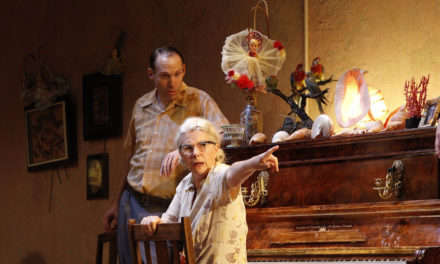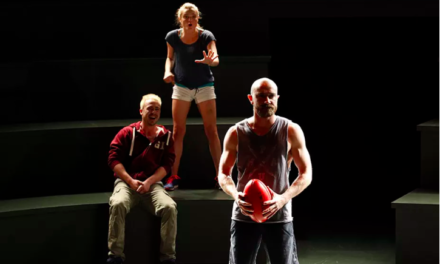Stabat Mater is the most recent work by Brazilian actress, playwright, and director Janaina Leite, in which she carries on a process that intertwines theatrical language and self-investigation. In March 2019, she shared her creative process of Stabat Mater at the 6th MITsp – Mostra Internacional de Teatro de São Paulo, and a few months later, the show premiered at CCSP – Centro Cultural São Paulo. Janaina Leite’s text had been selected as one of the finalists of an open call for playwrights, promoted by this venue the year before. I only had the chance to watch the play a few months later, when it was presented at Teatro de Contêiner, a significant venue in São Paulo.
This March 2020, Stabat Mater will be part of a Brazilian showcase at MITsp, in which curators from several festivals will have the chance to know this outstanding performance. Janaina Leite is a Researcher in Focus in this edition of the festival, so there will also be a program of reflexive activities dedicated to her work.
Janaina Leite’s investigations on contemporary documentary theater are focused on the autobiographical aspect. In Festa de separação [Separation Party] (2008) with Fepa Teixeira Pinto, they shared the process of their separation, telling their story and displaying video documentation of the farewell rituals they performed with friends and family. In Conversas com meu pai [Conversations with my Father](2014), written with and directed by Alexandre Dal Farra, she struggled with the memories of her deceased father and the possibilities of what she calls an incestuous relationship between them. She writes about those performances in her book, Autoescrituras performativas – Do diário à cena [Performative self-writings – From the diary to the scene].
Considering the artist’s coherent artistic trajectory, Stabat Mater comes as a considerable step forward in her ability to give formal elaboration to her ideas. In this work, she is not only responsible for the written text; she is now directing her own material, with the collaboration of an all-female crew. I believe the quality leap from Conversas com meu pai to Stabat Mater, a significant gain in her work with theatrical language, is the transition from a vacillating approach to the subject matter, sometimes stuck in some kind of artists’ crisis on talking about oneself, towards a radical confrontation of the autobiographical material as an actual labor the artist can do upon herself. There was a constant polarization between the real and the fictional in her previous work, as well as a dilemma surrounding the reliability of memory. In the most recent one, the debate reaches another level. The ideas of true X false, reality X fiction, are no longer taken as mutually excluding aspects. In fact, they don’t seem relevant at all. The notion of truth in Stabat Mater is considerably more complex and matured.
The critical reception of autobiographical works in Brazilian theater often demands some kind of overtaking, as if something has to happen beyond the “mere” sharing of a personal story. Janaina Leite’s dramaturgical procedures are loaded with those kinds of questionings, which emphasizes that talking about oneself is something invariably pervaded by its means and motivations. In Stabat Mater, self-reference is an inseparable part of the ongoing investigation. After all, the most enigmatic problems of individual life concern language, and they may demand a work on writing or speaking to be unraveled.
There is also another aspect of the critical reception of staged autobiographies of anonymous people that I would like to mention. It is often said that these performances are some sort of “therapy” in a pejorative way – as if any psychological process is nothing but a petty-bourgeois whim. Disregarding this completely, Janaina Leite is fully committed to her proposition of self-analysis, her necessity to investigate, and to put to the test some episodes of her private life and the way her memory deals with it. When she stages the session of family constellation she participated in, the audience can realize the proximity between the act of staging something and the processes of investigation of the self. By arranging bodies and objects to represent the relationships at stake, the theatricality of this form of therapy mirrors the dynamics of Stabat Mater. The play functions as an experimental arrangement of chemical components.
This combination of elements is written in the form of an essay and presented as a lecture-performance. The author shares her intuitive methodology and results with the audience. Her narrative is not afraid of groping through uncertain ideas. The dramaturgy is free to drift on its hypothesis and to experiment with its insights. It is very sharp and precise, although it doesn’t seem to try to be “objective”. In such a manner, Stabat Mater displays some aspects of contemporary documentary theater: it exposes structures of thinking, ways to read the world, reveals the emotional scaffolds that give form to affects, observes its own questionings, unfolds its parts, opens and exposes what is inside an idea, as in an autopsy – or a biopsy. Despite the intellectual elaboration of her argumentative exposition, the uptake of this work is not only about a cerebral understanding of its ideas.
Among the components the artist presents, the paramount element is the physical presence of her mother, Amália Fontes Leite. Considering that in her past performance, she investigated the complicated relationship with her father, now she pays attention to the fact that during all those years, she couldn’t see her mother as part of the complex family equation she was trying to solve. To face this confrontation, she brings her mother to the stage. She displays her presence as a fact to be acknowledged by the audience as well as by herself. The presence of Amalia is an active and reactive component for the formulation her daughter is examining.
There is also a male presence on stage, Lucas Asseituno, presented as Príapo and as “amateur”. His participation is key to the production of imageries concerning the mother-daughter-male figure triangle, but also referring to the Virgin Mary / Jesus Christ iconic image.
The Courage of Truth
The artist defines her performance as an act of parrhesia, “the courage of truth”. French philosopher Michel Foucault uses the word parrhesia to determine a precise idea of expressing the truth in pre-Socratic Greece. It implies an engagement that makes something happen to the one who speaks. Janaina Leite explains that parrhesia is something related to the bond between the one who speaks and what is spoken. So it is not an utterance that produces an immediate effect on the audience (as a theatrical trick that shocks or astonishes the spectator) but a gesture that implies a risk for the one who speaks. Foucault relates this concept to the care of the self through truth-telling or frank speech.
She is thus facing herself through orality, using the elaboration of creative theatrical language to give form to her narrative and to the debate she is proposing. But her struggle with herself must be accomplished with the participation of her body for the parrhesia to be performative, that is, so it may truly do something to her. This performative aspect promotes a change in the status of what is at stake – even if in subtle dimensions. In this case, as the truth-telling happens in the form of theater, the healing process occurs through poiesis. She also refers to a concept by Chilean writer and filmmaker Alejandro Jodorowski, the “psychomagic act,” to name what she is doing on stage: “a real action that produces symbolic consequences or a symbolic act that produces real consequences, but which can put those figures back to their proper positions.”
The point is that parrhesia necessarily demands someone to listen. Therefore, the show is not a “mere” personal storytelling, but something that necessarily requires the presence of an audience to happen. Someone has to stay there and listen.
Christianity, Porn and Horror movies
The title Stabat Mater is a Latin phrase that means “there was the mother,” referring to Mary’s endurance throughout Jesus’ Calvary. It is also the title of an essay – another nuclear element of the dramaturgy. In this essay, Bulgarian-French philosopher and psychoanalyst Julia Kristeva presents a critical view of Mary’s virginity and analyses the consequences of this aspect of Mary’s image in Christian culture, explicitly concerning women’s body. It seems that the word in Hebrew in the Scriptures refers simply to Mary’s age as a marriageable age. The term “virgin” would be a mistranslation, a deviation.
A woman becoming a mother without experiencing her sexuality, without pleasure, and despite her free will is nuclear to the construction of a given idea of womanhood. It formulates a culture that considers women’s bodies as receptacles, as a matter at the service of external and superior designs, and not as a living being. This iconic episode of divine conception without sex, which is fundamental to Christian mythology, is the nodal point of the fantasy, or rather, of the myth of female passivity. The association between motherhood and holiness, as if motherhood were a kind of antidote to the demonic nature enclosed in the female condition, to the fatal impurity of the adult woman’s body, is also a topic to be addressed.
Virginity as a value of purity is demonstrated in the performance regarding a recurrent narrative in horror movie scenarios: the survival of the “final girl.” The final girl is the female character who, within a group of other women who are sexually active and brutally murdered, she who is a virgin, therefore pure, manages not only to escape but sometimes to kill the predatory monster. The myth of female passivity is also investigated in the performance through an approach with the porn industry imagery. The idea of sexual intercourse in ordinary pornography displays the female body as something that can be opened and penetrated, as inert and available material. Its prime function is to “receive”. Horror movies have many sex scenes that end with the dismemberment of the female body. Porn images can also be quite similar to horror, as they deliberately emulate situations of rape, imprinting the free association between desire and violence on the image of the female body.
These eerie similarities meet real-life horror in the story of a cannibal necrophilic murderer, who is nowadays out of jail and selling books about his life. This case is approached in a performance by Spanish director Angélica Liddel, Qué haré yo con esta espada?. Although it is not directly mentioned in Stabat Mater, Liddel’s work is definitely a reference to this investigation of the obsession of patriarchal culture with the female body as material available for consumption, predisposed to any kind of violation. Janaina Leite’s work, like Liddel’s, avoids moralizing discourse – and that does not mean she intends to naturalize or to turn violence into a spectacle.
The Mother is Present

Janaina Leite and Amália Fontes Leite in Stabat Mater. Photo credit: André Cherri.
At a given point in the show, the play reports a situation of sexual violence. As her mother tells us, a man attacked Janaina in her neighborhood when she was walking alone to school as a young girl. But this real story in which her body has been dominated is only part of the problem. The invisibility of her mother in her psychic processes is the predominant topic, latent throughout the play. The mother appears on stage as symbol, myth, image, memory, as an index of reality, but also as someone who eventually shares her version and exposes her own burdens. Above all, she is the one who stays.
Her constant presence in the performance, however, is not inertia or passivity – despite her serene quality –, but a specific potency, an ancient resistance that gives the necessary firmness to the rope that sustains the whole show. It is the rope of listening, the tension which holds together the performativity of the parrhesia.
There is yet another very defining element, which functions as the bodily complement of the parrhesia. Janaina proposes to participate in a sex scene with a porn actor, directed by her mother. This provides a significant symbolic encounter, a coexistence of antithetical imagery: motherhood and pornography. This encounter, far from being an empty controversial trick, provides a risky situation of healing or at least of symbolic inversion. The idea of making a “real” sex scene with a porn actor, with the assistance of the mother, punctures two problematized conditions in the play: absence and passivity.
Regarding the absence, we can suppose the mother has always been present, that the problem was in the daughter’s eyes, that she couldn’t see the maternal figure that has been there all the time. On the other hand, we can also think about the burden of the mother’s absence on occasions when the daughter found herself in situations of menace. We do not know details about the relationship with the father, but we do know about the rape (recorded in the police report at the time as an attempted rape), which happened when she was alone. Demanding the presence of the mother in the making of a sex scene with a porn actor can be a tactic to subvert these narratives, by juxtaposing a new image to these old memories. And it might work for the sake of them both, daughter and mother, however uncomfortable it may be.
Furthermore, putting herself in a situation of producing porn images can be a manner of subverting the myth of female passivity – with the participation of the body and not only through discourse. That is the fundamental profanation. Considering the artist’s own experience of becoming a mother, she shows a video of the birth of one of her children. The editing of this material creates a strong inversion, an image that disturbs the pornographic repertoire and the ideal of purity commonly related to motherhood. By rewriting these images and turning narratives inside out, Janaina Leite molds her choice of not being a victim, of not being a receptacle. She combines these elements to produce a sound affirmation of the courage to speak and of the courage to do. Her poetic elaboration is an affirmative statement of her rightful position.
Bibliography:
LEITE, Janaina Fontes. Autoescrituras performativas: do diário à cena. São Paulo: Perspectiva, Fapesp, 2017.
Originally published online in Portuguese by Questão de Crítica on November 16th, 2019 http://www.questaodecritica.com.br/2019/11/stabat-mater/
This post was written by the author in their personal capacity.The opinions expressed in this article are the author’s own and do not reflect the view of The Theatre Times, their staff or collaborators.
This post was written by Daniele Avila Small.
The views expressed here belong to the author and do not necessarily reflect our views and opinions.


















